Last year social media users spent about an hour on Instagram every single day — and that’s just on average. Whether you’re an IG pro or a newbie, every musician can appreciate the power of a good profile, but how can you really leverage Instagram as an effective marketing tool for your music career?
If you’re a musician hoping for some new fans on the Gram, you’re in luck, because DIY music guru, Ari Herstand is taking over our blog for the day.
Herstand’s the creator behind the popular blog Ari’s Take and Ari’s Take Academy, where he shares essential tips and info on how to truly make it in the music industry. Ari’s both a best-selling author and esteemed musician, currently leading the funk project Brassroots District. He’s spoken at SXSW, BBC One’s Amplify, written for publications like Digital Music News, and now, here, to give the low-down on how to master the art of the ever-elusive, Instagram.
We’re excited to share with you an exclusive excerpt from Ari’s book, How to Make It in the New Music Business (2nd Edition). Take notes!

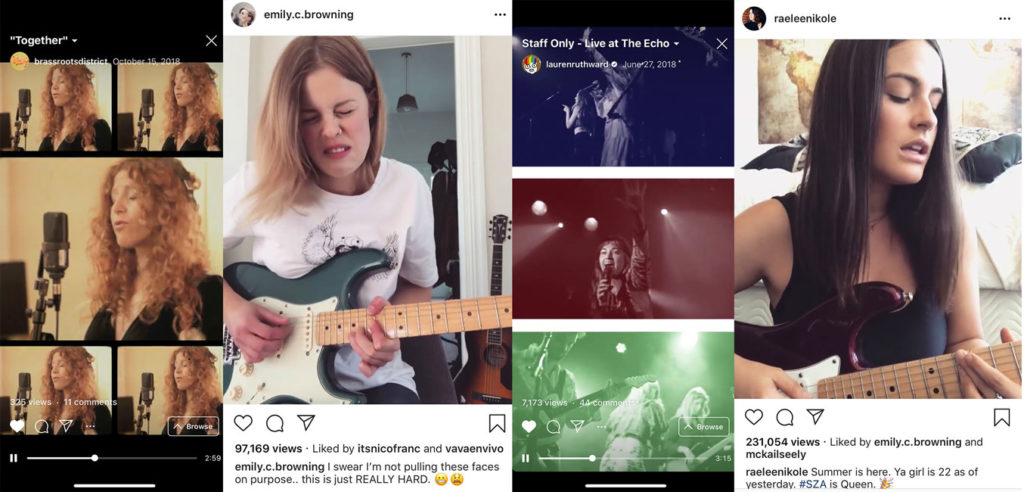
This is an excerpt from Ari Herstand’s book How to Make It in the New Music Business (second edition):
A relatively unknown 33-year-old singer/songwriter, Rachel Platten, released her single “Fight Song” on February 19, 2015. She had about 35,000 Instagram followers at the time. The song was just bouncing around adult radio (with a push from her label, Columbia), struggling to gain traction. On June 6, though, that all changed. Rachel’s manager, Ben Singer (also Andy Grammer’s manager), contacted Taylor Swift’s manager to see if Taylor would be into meeting Rachel backstage after Taylor’s arena show in Pittsburgh. Hours later, Taylor Swift Instagrammed a 15-second video of the two rocking out backstage to “Fight Song” with Rachel on guitar. Of course, Rachel was tagged, and Taylor Swift’s 50 million Instagram followers wondered a) what song this was, and b) who was Rachel Platten? Within hours, Rachel’s Instagram followers doubled. And by the next day she had well over 100,000 Instagram followers. “Fight Song” reached #1 on the iTunes charts. And a month later it cracked the top 10 Billboard Hot 100 and went on to be a worldwide hit. All from one Instagram video. And, of course, a great song.
Instagram has evolved from simply a photo-sharing app to one of the most important apps for creating an Artist world and engaging an audience. Subcommunities have now popped up within Instagram that have single-handedly launched careers. @pickupmusic, @pickupjazz, @brilliantmusicians, @musiciansshowcase, @talented_musicians, @chorus and @omgvoices were some of the first (and most powerful) accounts to feature the musicians of Instagram. PickUp has actually grown into a musicians’ community, regularly hosting events around the world.
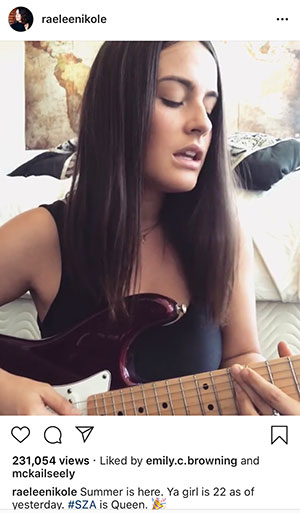

San Diego native Raelee Nikole (@raeleenikole) had been gigging around her hometown since she was seventeen. She’d had an Instagram account since the beginning of the platform (circa 2012) and posted to the platform like every other teenager. But it wasn’t until late 2016 when she posted a video of herself playing guitar and singing Musiq Soulchild’s “Just Friends” that everything changed. The @pickupjazz account featured her video, and followers came pouring in for Raelee. The next video she posted, playing the guitar part for John Mayer’s “Paper Doll,” John Mayer himself commented on the video. She attracted more and more attention as she posted more and more videos. Shawn Mendes followed her and even tweeted one of her songs (which subsequently hit Spotify’s Viral 50 chart). Shawn introduced Raelee to his writing partner, Scott Harris, and soon Raelee was writing with some of the biggest songwriters in the world.
Also in 2016, New Zealand–based Emily C. Browning (@emily.c.browning) attended an Instagram clinic Sam Blakelock of @pickupjazz (also a New Zealand native) held. Emily, an incredibly talented guitarist/singer/songwriter, posted a cover song, tagged @pickupjazz, and soon she was featured as well. She began regularly posting songs on her account and got featured on not only the @pickupjazz account, but a few other popular music-focused accounts. About a year into the process, she looked at her Instagram analytics and realized she had a lot of followers in Los Angeles, so she booked a trip out to L.A., teamed up with a couple other L.A. musicians she had met on Instagram and sold out her very first show in the United States.


- Quality Content You can’t fake your way to success on Instagram. The algorithm has gotten incredibly smart and highlights great content—regardless of the subject matter.
- Positive Community Make sure you reply to some of your comments and interact with people in your DMs. But keep it positive. If people are trash-talking in your comments, don’t stoop to their level or engage combatively. This ain’t Facebook.
- Consistency “You’re not going to over-post if the content is high-quality and is varied,” he says.
- Trial and Error You don’t want to merely be a follower on Instagram. You want to be a leader and experiment with ways to engage and grow your audience. Learn from other successful accounts, but come up with ways that showcase your personality and skills best.
- Collaboration Find people who are doing what you want to do and collaborate with them.
Like YouTube, some of the most successful Instagrammers collaborate. It could be tagging the company who made a dress, tagging everyone in the photo, including friends in your Stories and showcasing their handles, mashing up other videos with your own, giving a shout-out to someone in the comments or making friends in the DMs. And you don’t actually have to be in the same time zone as your collaborators. Just tag them and they may Regram and tag you back, as has been the case with the popular musician-feature accounts.
After Raelee Nikole posted a 20-second clip of her playing/singing her neosoul rendition of SZA’s “The Weekend,” New Zealand–based (something’s in the water) @thejuneyboy took her video, sliced himself into it (cutting back and forth between her and him) and remixed her original audio, adding a beat and some lead guitar. This may not sound that impressive as remixes happen regularly now, but remember that at the time, it took figuring out how to download her video (through hacks—as Instagram doesn’t enable this), then dumping the audio into a DAW, mixing in his own creation, then syncing it back up to video (cutting in his own video). The remix video got over 150,000 views on her profile. Similarly, @p_larddd remixed Raelee’s rendition of “Redbone.” She Regrammed it with “Shoutout to 2017 for giving kids with bedrooms on opposite sides of the country a way to shed together!”
Multi-instrumentalist Elise Trouw (@elisetrouw) was incredibly active within the community when she first started on the platform. She regularly posted videos of herself singing, playing drums, bass, and guitar, and similarly got featured on popular musician-feature accounts (long before her looping videos on Facebook and YouTube went viral).
Again, it’s not about one viral video; it’s about staying active within the community, regularly releasing high-quality content, staying genuine (not forcing anything), trying (and failing) incessantly, and keeping up with the trends of the times.
When Story Highlights were released, many musicians got creative and used the story bubbles at the top almost how a website toolbar functions: Music, Videos, Tour, Vlog, Merch, etc. Highlights with full Swipe Up capabilities per highlight. In the Tour Highlight, they could post a photo per date with the Swipe Up linking directly to purchase tickets. The Videos Highlight could feature various video clips with the Swipe Up function linking to the full video. Merch Highlight could feature merch items with the Swipe Up feature linking directly to each item on your website. Some just posted one image per Highlight (Spotify, YouTube, Apple Music, Tour, etc.) and linked directly to that. You get the idea.
When IGTV was released, people created content specifically for the medium. Lauren Ruth Ward (@laurenruthward) created a live performance video from one of her recent shows at the Echoplex in L.A. that was vertical, with multiple camera angles stacked on one another, popping in and out, off and on. This style of video editing wasn’t prevalent anywhere else at the time (because it wouldn’t work as well on any other platform for any other medium). But it was perfect for IGTV. The 1975 made a custom (vertical) lyric video for their song “Give Yourself a Try,” which played on the same aesthetic theme of their main music video but was specific for the platform. (They also made similar videos exclusive to Spotify for their 2018 releases.)
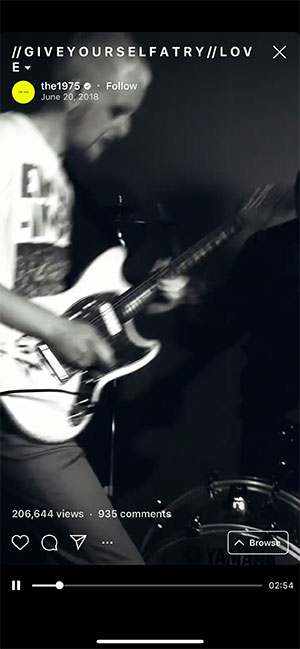
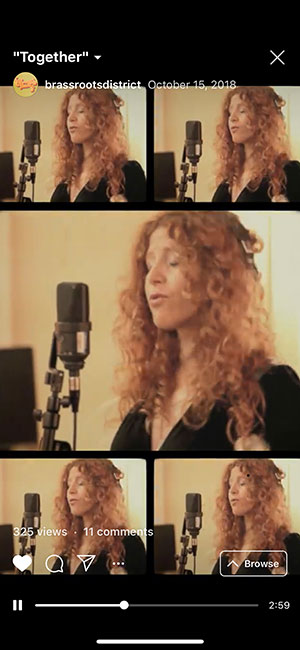
Bands often struggle with how to effectively use Instagram. As the platform evolves, former tips and tricks become obsolete or frowned upon. At one point, utilizing a bunch of hashtags was a sure way to get discovered by new followers. But when Instagram changed their algorithm, hashtags weren’t as effective as they once were. Early on, just throwing a filter on a crappy photo was sufficient. Now, many edit their photos by utilizing outside apps like Afterlight or Snapseed. Keeping up with the trends is vital to being a welcome presence on the platform. You shouldn’t use Instagram the way you use any other social network. It’s a different community and there is different etiquette.
A good rule of thumb for keeping your Instagram feed engaging is to post photos and videos of you and include your face in the majority of your Stories. Your fans don’t care what your salad looks like. That’s not interesting. But you holding that same salad, in the green room, before you play a show? That’s interesting. Following you on Instagram (and every platform), your fan should feel connected to you. Posting a video of just your hands playing guitar is not going to get anyone to identify with you the person. The artist. Seeing a photo of the empty club pre-show isn’t interesting. Seeing you in that same photo makes it a hundred times more interesting and gets your fans to connect with you on a deeper level. You make them feel like they are there with you. Anyone can post a photo of an empty club. How do they know you didn’t just pull this from the Internet? Because you’re in it! Posting a photo of just your friend’s face may be hilarious to the both of you, but none of your fans will get the joke. You just insulted everyone who doesn’t know your friend. “Ha-ha, you don’t get our inside joke!” The goal on Instagram is to get your audience to identify with you. Sure, post photos of your friends and include them in your Stories, but make sure you’re in them as well. Go through your Instagram feed right now, and I bet you loads of money that the posts that have the most likes are ones you are in.
But be careful about the kinds of content you post. You want to attract the kinds of followers who will turn into supportive fans (of your music). If you just post photos of you in a swimsuit, you may get a lot of followers who like how you look in a swimsuit. You may think more followers is always better, but you’d be wrong. You’ll soon notice that photos of you in swimsuits will continue to do great and videos of you playing music won’t do so well. People are there for your body, not your music. And because most of your followers engage with your swimsuit photos, the algorithm will recognize what people respond to the most and will bury your music posts and feature your swimsuit posts. Similarly, if you post covers of popular songs you hate, you may get a bunch of followers who are fans of those songs, but when you start posting your original music, they may not like it and not engage—training the algorithm to bury the music that is most meaningful to you.
You don’t merely want more followers. You want to build a highly engaged community of supporters who dig the authentic you. And will stick with you for life.
About the author:
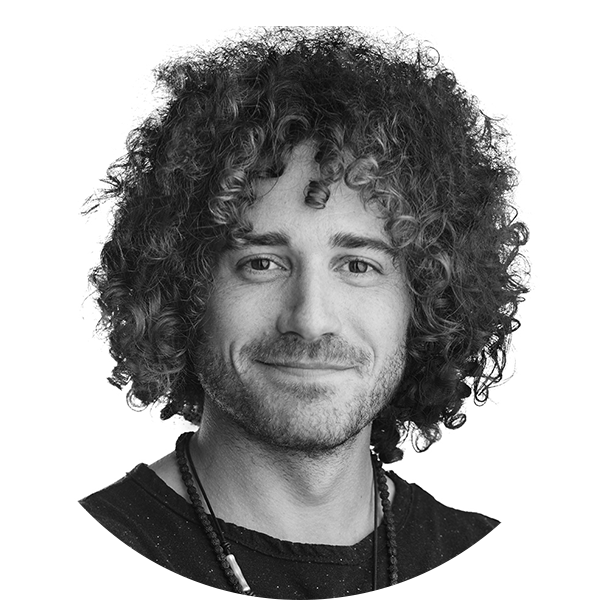
Deemed the “poster child of DIY Music” by Forbes, the LA-based writer’s blog Ari’s Take has become deemed the “poster child of DIY Music” by Forbes, the LA-based writer’s blog Ari’s Take has become a vital resource for thousands of musicians breaking into the music industry. Herstand’s a skilled musical artist in his own right, with 700 shows under his belt, touring with the likes of Ben Folds, Ron Pope, and Matt Nathanson, to name a few. He’s performed on Ellen and many of his songs have been featured on commercials, films, and TV shows. Follow him on Instagram @ariherstand.


